Artie’s ARSandbox
Assembled by Sean Robinson
This page documents the ARSandox as built at Scottsdale Community College.

Hardware
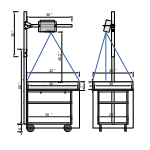
The base is an Equipto Four-Tray-33″ high cart (part number 160) with a wooden box and square-tube riser attached. This cart has a 500 pound listed capacity, more than enough for this project. The top tray has been turned upside down to leave a flat surface for the sandbox to be fixed to the cart top with 1/4 x 2-inch bolts. The bolts are counter-sunk in the box bottom and the holes are filled to seal against sand spilling and jamming fingers into the bolt holes.
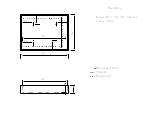
As recommended in the ARSandbox directions, our sandbox is filled with 200 pounds of Sandtastik White Play Sand from Staples Business Advantage. I mention the source here because, at the time, MCCCD was in a contract with Staples, which made it inexpensive to have 8 25-pound boxes of sand delivered to campus.
The riser is made from Tapco 2-inch and 2.25-inch perforated, galvanized steel, square tubes. The Tapco 054-00043 96-inch long (2 inches on a side) tube was cut into 60-inch and 36-inch lengths. The lower, 60-inch tube is bolted onto the cart with 7/16 x 3-inch bolts.
The upper, telescoping portion, is a Tapco 1603-00008 36-inch long by 2.25-inch square post. This upper piece has an 18-inch travel distance to allow retraction while moving the cart, especially through doorways. There is a 6-inch overlap when the upper tube is fully extended to allow three 7/16 x 3-inch bolts to secure the upper tube. With the 6-inch wheels on the cart, the overall riser height is 96 inches in its operational configuration and 78 inches for transport.
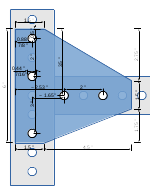
The telescoping assembly includes the riser tube, the cross tube gussets (plates), the cross tube, the camera mount, and the projector mount. Bolted onto the 2.25″ tube are custom-crafted gussets made from 0.125-inch steel plate. The other side of the gusset is bolted to the 36-inch long (2 inches square) cross tube with washers filling in the difference in widths.
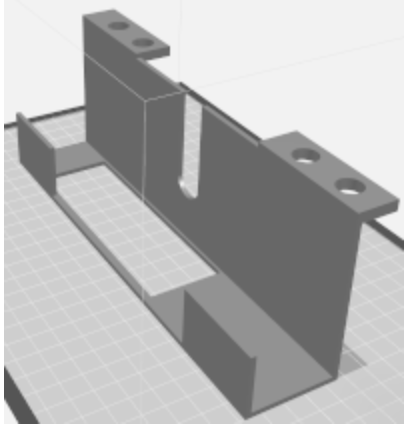
The cross tube holds the Kinect camera mount (named the KinectCage) and the projector mount. The camera mount was designed by Dylan Salam and printed on one of SCC’s 3D printers.
The projector mount is another custom-made piece. The digital projector is attached to a 0.0598 inch (16 GA) thick piece of low-carbon steel. The sheet is 8 inches by 15.25 inches and extends about 2 inches (on both sides) past the projector length. The steel plate has 4 mm holes to allow three M4x25 screws to attach the plate to the projector bottom. Two 0.5-inch holes are located on the 2-inch “wings” to allow 7/16-inch by 9.5-inch threaded rods, secured to the cross tube, to hold up the metal sheet.

The logo (photo at top of page) was printed on one of the 3D printers in the SCC Engineering program.
The computer was repurposed by the SCC IT department. Originally, used by the SCC Architectural program, the ten year old machine is still powerful enough for the SARndbox software.
The skirt was made from fabric, Aleene’s Fabric Fusion glue, and strips of cardboard to provide stiffening for the upper edge. The skirt is held on by Velcro stapled to the cardboard stiffener and glued to the sides of the box. The skirt edges are finished with a straight stich using a sewing machine.
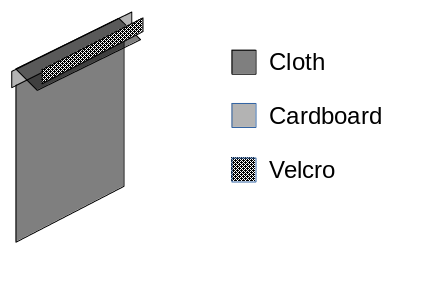
To connect the Kinect camera via USB, a 9-foot USB 2.0 extension cable is used. A 15-foot DisplayPort to HDMI cable connects the NVidia Quadro 2000 video card to the BenQ MW632ST projector.
Software
Artie’s ARSandbox uses the GPL-licensed Vrui, Kinect, and SARndbox programs:
The Augmented Reality Sandbox was developed by the UC Davis W.M. Keck Center for Active Visualization in the Earth Sciences (KeckCAVES, http://www.keckcaves.org), supported by the National Science Foundation under Grant No. DRL 1114663.
The SCC installation has been customized with a second hand gesture. The default SARndbox application has a “rain” hand to render adding water onto the projected map. Artie’s ARSandbox also has a “drain” hand to evaporate water off the projected map. This can be found at GitHub.
Acknowledgments
Adam Woodard donated the Kinect and adapters, starting the SCC project.
Robert Kelso constructed the sandbox proper, cut the steel tube, fabricated the steel gusset plates, and made the project physically fit together and look good.
Dylan Salam designed the Kinect camera cradle.
Michael Canham printed 3D models for the logo and camera cradle.
Nathan Guardino helped select and purchase the digital projector.
Oliver Kreylos and KeckCAVES for the ARSandbox software, documentation, and videos.